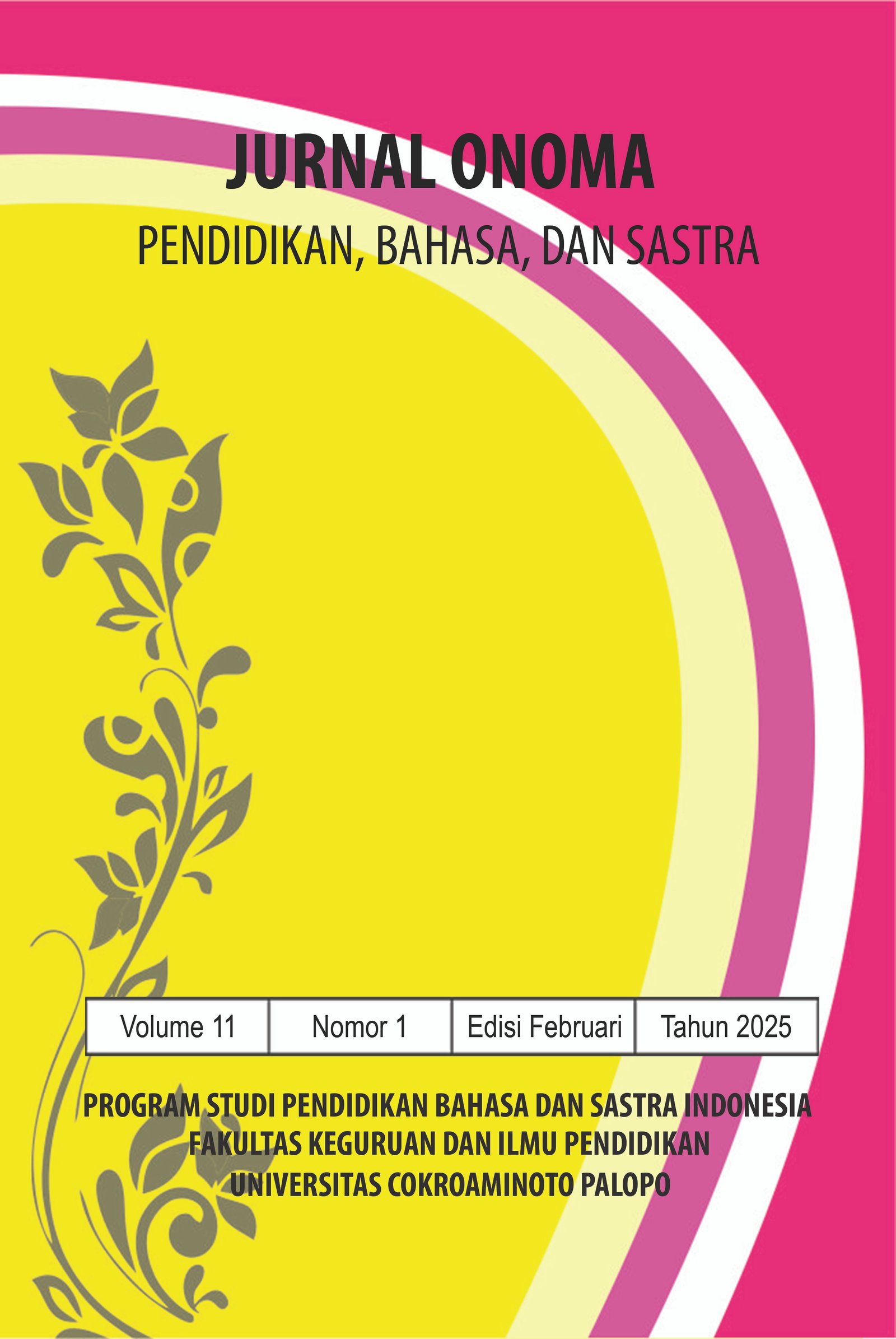Penggunaan Bahasa Gaul di Kalangan Remaja terhadap Kelestarian Bahasa Indonesia di Era Digital
https://doi.org/10.30605/onoma.v11i1.5018
Keywords:
Bahasa Indonesia, Bahasa Gaul, Era DigitalAbstract
ekspresi diri, alat komunikasi, serta pengaruhnya terhadap identitas sosial remaja. Metode yang digunakan dalam penelitian hal ini ialah metode kualitatif, melalui studi pustaka melalui berbagai media sosial contohnya, Tiktok, Instagram, Facebook, dan Twitter. Berdasarkan hasil penelitian, menunjukka bahwa media sosial sangat dalam menyebarkan istilah baru khususnya pada di kalangan remaja. terdapat empat bentuk dalam penggunaan bahasa gaul oleh , yaitu: akronim, penggunaan frasa dari bahasa asing, singkatan kata, serta penciptaan istilah baru. Kemudian fungsi penggunaan bahasa gaul sebagai sarana untuk mengekspresikan diri, menjalin komunikasi, memperkuat integrasi serta adaptasi sosial, dan sebagai alat untuk pengendalian sosial. Penelitian ini juga memfokuskan pada pengaruh bahasa gaul terhadap identitas kebahasaan di era digital.
Downloads
References
Budianto, Edi. (2016). Bahasa Gaul dan Identitas Kebudayaan di Era Digital. Jakarta: Kompas Media.
Chaer, A. (2012). Psikolinguistik: Kajian Teoretik. Rineka Cipta.
Chaer, Abdul, & Agustina, Leonie. (2010). Sosiolinguistik: Perkenalan Awal. Jakarta: Rineka Cipta.
Keraf, G. (2009). Diksi dan Gaya Bahasa. Gramedia Pustaka Utama.
Kridalaksana, H. (2008). Kamus Linguistik. Gramedia Pustaka Utama.
Kridalaksana, H. (2001). Pembentukan Kata dalam Bahasa Indonesia. Jakarta: Gramedia Pustaka Utama.
Mulyana. (2008). Bahasa Indonesia untuk perguruan tinggi. Rembang: Yayasan Adhigama.
Santoso, R. (2020). Bahasa, Media Sosial, dan Remaja: Perspektif Linguistik. Yogyakarta: Penerbit Ombak.
Soekanto, Soerjono. (2006). Sosiologi: Suatu Pengantar. Jakarta: Rajawali Press.
Sugiyono. (2015). Metode Penelitian Kuantitatif, Kualitatif, dan R&D. Bandung: Alfabeta.
Sulemana, J., dan Islamiyah (2018). Dampak Penggunaan Bahasa Gaul di Kalangan Remaja terhadap Bahasa Indonesia. Prosiding Seminar Nasional Bahasa dan Sastra (SENASBASA), Edisi 3, 153-158. Universitas Veteran Bangun Nusantara Sukoharjo. http://research-report.umm.ac.id/index.php/SENASBASA.
Zein, D., & Wagiati, W. (2018). Bahasa gaul kaum muda sebagai ekspresi kreativitas linguistik di media sosial dalam era teknologi komunikasi dan informasi. Jurnal Sosioteknologi, 17(2), 236. https://doi.org/10.5614/sostek.itbj.2018.17.2.6 DOI: https://doi.org/10.5614/sostek.itbj.2018.17.2.6
Downloads
Published
How to Cite
License
In submitting the manuscript to the journal, the authors certify that:
- They are authorized by their co-authors to enter into these arrangements.
- The work described has not been formally published before, except in the form of an abstract or as part of a published lecture, review, thesis, or overlay journal.
- That it is not under consideration for publication elsewhere,
- That its publication has been approved by all the author(s) and by the responsible authorities – tacitly or explicitly – of the institutes where the work has been carried out.
- They secure the right to reproduce any material that has already been published or copyrighted elsewhere.
- They agree to the following license and copyright agreement.
License and Copyright Agreement
Authors who publish with Onoma Journal: Education, Languages??, and Literature agree to the following terms:
- Authors retain copyright and grant the journal right of first publication with the work simultaneously licensed under Creative Commons Attribution License (CC BY 4.0) that allows others to share the work with an acknowledgment of the work's authorship and initial publication in this journal.
- Authors are able to enter into separate, additional contractual arrangements for the non-exclusive distribution of the journal's published version of the work (e.g., post it to an institutional repository or publish it in a book), with an acknowledgment of its initial publication in this journal.
- Authors are permitted and encouraged to post their work online (e.g., in institutional repositories or on their website) prior to and during the submission process, as it can lead to productive exchanges, as well as earlier and greater citation of published work.

















